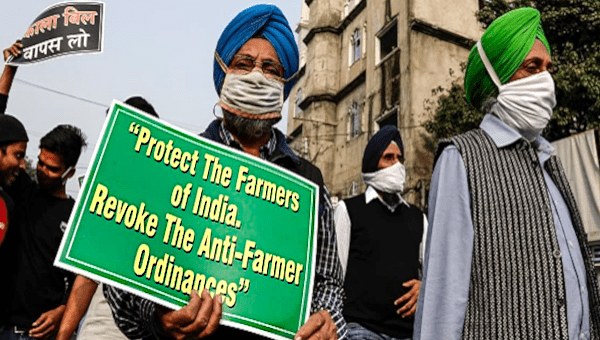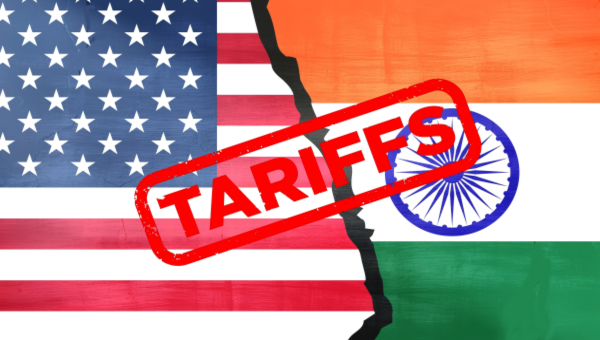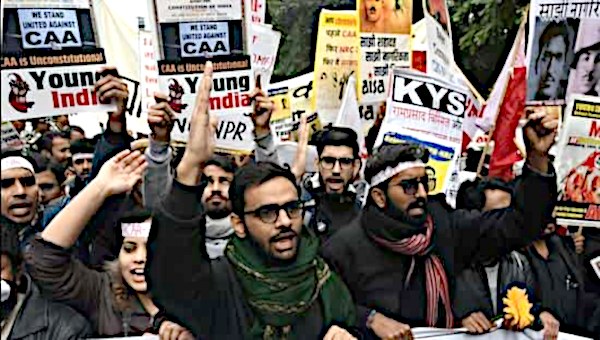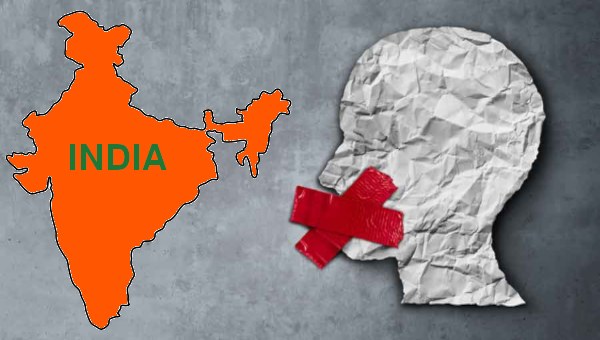Peasants and Politics in Neoliberal India: The 2020-21 Peasant Movement
The persistence of peasantry in the Global South and imperialism’s necessity to integrate it into its accumulation network has given birth to a new agrarian question. This question centers around policies and efforts employed by imperialist countries to pressurize countries of the Global South, through international institutions (WTO, World Bank, and IMF), to integrate their peasantry into globalized capital. A peculiar feature of recent developments in this process is the exceptional support extended by the big corporate capital to right-wing forces.
In the Global South, India is home to the world’s largest peasantry,1 with about 55 percent of the total workforce directly dependent on agriculture for their livelihood. The legislative interventions by the Indian state in the middle of the COVID-19 pandemic in 2020 in the form of the three farm laws (The Farmer Produce Trade and Commerce (Promotion and Facilitation) Act), The Farmers Agreement on Price Assurance and Farm Services Act (Empowerment and Protection), and The Essential Commodities (Amendment) Act) was a major step toward bringing Indian peasantry under the direct rule of big agro-corporate capital. This triggered a massive India-wide protest that lasted over a year and ultimately led to the repeal of the three farm laws.
The impact of this movement is evident in the recent general elections in India, which showed a dramatic fall in the incumbent Bharatiya Janta Party’s (BJP) seat tally from rural areas. This movement has cultivated a new consciousness in rural India, undermining the BJP’s communal politics. In the 2024 election, BJP won just 165 seats out of 398 rural seats, compared to 236 seats in 2019. This setback is due to the BJP government’s authoritarian approach to integrating agriculture with big-corporate capital and its failure to address the core needs of rural areas, such as investment in rural infrastructure, basic amenities, and employment opportunities.

Peasant Unions Against Modi
Punjab was the epicenter of the 2020-21 peasant movement. Its peasant unions initiated mobilizations against the farm laws that quickly spread to rural areas of Haryana, Uttar Pradesh, and Rajasthan. The left-wing peasant unions of Punjab were at the forefront of this movement.
Punjab, with only 1.5 percent of the country’s total geographical area, owns one of the most productive lands in the world and is the largest grain producer in the country. The quality of its land has consistently placed it under the sharp focus of the ruling power alliances of the time: the Indian state after its independence in 1947 and the state-corporate nexus in the neoliberal era. As a result, the region’s peasantry, known to be the most organized peasantry in India, has cultivated a rich history of struggle to safeguard their lands from these dominant forces. For instance, in 1907, Punjab’s peasantry waged a long struggle, lasting seven months, against the British imperialist policies that impinged on their land rights and agricultural production. More than 100 years later, Punjab’s peasantry led the 2020-21 peasant struggle that has come to be regarded as one of the longest and largest peasant struggles in the history of modern India. The significance of the 2020-21 peasant movement lies in its mobilization, protest strategy, and inclusivity. Notwithstanding these merits and its immediate success with the repeal of the three farm laws, the movement failed to advance a socialist agenda. Instead, in Punjab, Sikh separatist forces have capitalized on the movement to promote their own objectives.
BJP’s Pro-Corporate Agenda and the Power of Agrarian Populism
The neoliberal ideology ruling over India’s political economy for many decades entered a new phase with the exceptional support of the national and international capitalist class for the right-wing BJP since the 2014 elections. Aligning with imperial and national capital interests, the BJP has steered India’s political economy in a manner that has accelerated the process of primitive capitalist accumulation in the country. Rural India, where the majority of the country’s population resides (about 900 million), remains poorly integrated with corporate capital, and most of its population depends on agriculture, petty production, and farm and non-farm labour. The BJP government was heavily sponsored by the national and international capitalist class to implement the imperialist agenda of integrating rural India into the network of big corporate capital. The introduction of the three farm laws during the COVID-19 pandemic, a time when people awaited a fiscal stimulus from the government to alleviate pandemic-induced hardships, was a planned and perverse attempt to give a big push to the neoliberal project in India. The ruling BJP government, emboldened by its majority, was confident that the farming community would offer little resistance, particularly in light of the recent repression of various minority movements by the state. The introduction of the farm laws was insidious in another respect. Their imposition in an authoritarian manner, without democratic deliberation and consultation with the state governments, was an assault on the federal system of the country.
The victory of the peasant movement following the repeal of the three laws revealed a grave miscalculation of the strength of the farming community by the BJP government. The 2020–21 peasant protest occurred at a time when almost all the trade unions shied away from challenging the anti-people attitude of the right-wing authoritarian state in India. The movement began with peasant unions and pro-people intellectuals spreading awareness about these laws and their impact on income, land rights, and freedom of cultivation. The fear of losing both the minimum support price (MSP) and the freedom to cultivate crops also played an important role in the unions’ mobilization of peasants against these laws. This was the first time in the 21st century that the peasantry came out in large numbers to challenge the imperialist project on a pan-India scale. The movement was led by Samyukt Kisan Morcha (SKM) – a united front formed by the 32 peasant unions of Punjab, subsequently supported by the All India Kisan Sangharsh Coordination Committee (AIKSCC), a platform of nearly 400 peasant organizations. The protest was joined by unions from other states, pro-people national and international organizations, and even the Punjabi diaspora.
The strategic approach to protest adopted by the union leadership was notable, with protesting peasants peacefully obstructing major roads leading to India’s capital city, Delhi, dealing a significant blow to the capital’s economic circuits. This tactic was popularized by the actions of BKU (Ekta-Ugrahan) in Punjab, where they protested against large corporate entities such as Reliance petrol pumps, shopping centers, Adani silos, and toll plazas. The participation of regional singers, women, students, sports players, NGOs, etc., was an important aspect of the movement. Scholars also emphasize the cross-class and caste alliances formed during the movement. They argue that these alliances across class and caste lines are essential to challenge the authoritarian and imperialist project in India. These alliances were an outcome of the gradual subjugation of the agriculture sector under the neoliberal project that prioritized the interests of corporate and financial oligarchy over the rural hegemonic classes (wealthy peasantry). The diminishing significance of the agriculture sector in the national economy, coupled with the declining political and economic influence of rural elites, alongside the increasing impoverishment of small peasants, agricultural labourers, and informal workers, served as key factors fostering unity across classes and castes.
Compared to the previous peasant movements, the active participation of women in this movement was also a notable feature. Women in large numbers from Punjab, predominantly from small and marginal peasant households, as well as Dalit women from landless agricultural households, camped at the Delhi borders. Their robust participation can be attributed in part to the efforts of BKU (Ekta Ugrahan), which, on the occasion of International Women’s Day (8 March), mobilized over 50,000 women workers and peasants.
The victory of this movement reignited memories of the long history of peasant protests against the injustice of British imperial policies and the resistance, as well as victories, of the united efforts of the peasantry and pro-people activists during that time. Most scholars contend that the victory of the 2020-21 peasant movement serves as a testament to the effectiveness of peaceful yet persistent resistance against the anti-democratic tendencies of imperialist and authoritarian alliances, bearing significant implications for progressive politics in the foreseeable future. However, evaluating the outcomes of this movement from the rural poor’s perspective, a minority view led by the Marxian political economists, argued that agrarian populist forces eventually hijacked the movement, sidelining the class politics needed for an egalitarian resolution of the agrarian question.
Agrarian Populism or Class Politics
Most narrative accounts of the 2020-21 peasant movements, while detailed and informative, do not employ a class lens to comprehend the complexities associated with the alliance of imperialism and the state-corporate nexus, nor the internal dynamics within the peasant classes. This black-boxes the peasantry and their struggle, undermining the uneven social and economic realities of different peasant classes. I argue that to fully understand the imperialist integration project and peasant movements against it, a comprehensive analysis necessitates a Marxian approach. This approach should simultaneously examine imperialist encroachment, the role of the local state, and the influence of privileged rural classes.
Most scholars examining this movement focused predominantly on describing the characteristics and successes of this struggle (which may have been essential at that moment). However, their method of analysis tends to oversimplify complex issues and foreground easily understandable narratives rather than engaging in a thorough examination through the Marxian class lens. Surprisingly, only a few scholars have attempted to understand the 2020-21 peasant movement within the context of the mountainous agrarian distress and growing imperialist encroachment. I argue that such contextualization is crucial for a deeper understanding of the underlying power dynamics driving the peasant movement and its broader socio-economic implications.
This prompts a critique of the peasant movements in the Indian Punjab. The historical analysis of peasant movements reveals that after the introduction of Green Revolution technology during the 1970s in Punjab, a new class of rich peasants took command of both agricultural production and politics. Since then, the peasant movements in Punjab have often veered toward maintaining the status quo rather than catalyzing significant social or economic transformation. The leadership of the majority of the populist peasant unions who participated in the 2020-21 struggle were rich capitalist farmers. On the terrain of real social issues or economic poverty of marginalized rural classes, these unions align with the camp of dependent capitalism. This is apparent in the downward evolution of the movement’s objectives from its initial eight demands, which notably addressed the concerns of landless labourers, impoverished peasants, and tenants, to a singular focus on advocating for the repeal of the three farm laws.
To understand the leadership problematic, I have divided the left-wing peasant unions, directly or indirectly affiliated with the Maoist ideology, into two broad groups. It is important to note here that while other left-wing unions exist in Punjab, those included in this classification are the most dominant in terms of membership and influence. I argue that the principal reason behind the partial success of peasant resistance in bringing about progressive political change in the condition of the peasantry and rural working masses is the differences between these two groups regarding the concrete material realities of the peasantry and their rigidity to their espoused principles, and their respective weaknesses that spring from this rigidity.
While both groups are opposed to imperialism and its state support, they differ in their modes of operation, specifically the alliances they form. The first group (led by BKU-Krantikari) believes that to challenge imperialism and the complicit Indian state, they must seek to include Sikh separatists – who are also opposed to the state (which the latter understand as a Hindu majoritarian state) – in alliances for political action. The union leaders of this group believe that Sikh separatists can act as a Jacobian force for their revolutionary struggle. In this, they disregard the ideological void within the Sikh separatist movement. This void, echoing Samir Amin’s observations in another context, stems from the fact that despite claiming religious or cultural objectives, Sikh separatists, rather than being genuinely concerned with theological discussions, are preoccupied with “the ritual assertion of membership in the community.” Focusing solely on religion enables separatists to sidestep the genuine social conflicts between the marginalized classes and the dominant capitalist system. This leads to two distressing consequences. Firstly, it changes the character of the peasant movements from an anti-imperialism and class movement to an anti-Hindu majoritarian state, which only leads society into an impasse. Secondly, their aggressive approach, lacking an emancipatory agenda against capitalist-imperialist exploitation, serves to justify the state’s use of repressive measures to suppress genuine movements for marginalized groups, all under the guise of preserving national unity.
I argue that the left-wing unions favoring an alliance with separatist forces need to be reminded that these forces are fundamentally regressive on the social plane. They can often be found celebrating feudal institutions, orthodox values, and capitalist culture and lifestyles in rural Punjab. Moreover, they have no real presence in the areas that are most affected by the agrarian distress, and thus, they do not offer meaningful support for the struggles of the popular classes against the system responsible for their poverty.
The other Maoist group (led by BKU Ekta-Urgahan and Kirti Kisan Unions) argues that mass consciousness and everyday resistance are the means to challenge capitalism-imperialism. They do not favor forming any alliance with the culturalist and religious forces to struggle against the state-corporate nexus. Rather, they are critical of these groups by blaming them for derailing people’s movements against capitalism-imperialism. They are often criticized by the previously discussed Maoist group for not having a clear political agenda. This is true to a certain extent, as they believe in everyday resistance without rooting these struggles in some forward-looking concrete political change. They favor the boycott of elections but they remain silent about how boycotting elections can reduce the misery of poor peasantry and agricultural labourers.
I argue that their boycotting tactics lead to a distressing cycle of fighting against the government in power without providing a formidable alternative to it. They make no serious efforts to produce class consciousness among their cadre to become a political agency that can challenge the existing power structure. The irony is that they advocate the mass line ideology and yet attempt to attain the state’s power without concrete steps toward attaining political agency (party). This, I argue, is a fundamental question that they need to address for progressive political change.
Concluding Remarks
In summary, the space that left-wing unions extended to the Sikh separatist forces and populist peasant unions altered the trajectory of the 2020-21 movement. As a result, the movement shifted from being a progressive political force to one that upheld the status quo. Sikh separatists exploited the peasant unions’ platform to strengthen their agenda by corrupting the consciousness of desperate youth and using them for their personal political interests. They won two Lok Sabha seats from Punjab in the 2024 elections. This victory was largely due to the failure of the left-wing unions to keep command of the peasant movement in their own hands and their lack of guidance during the Lok Sabha elections, which left their supporters without direction to vote for left-wing parties.
I argue that to bring progressive political change in the near future, left-wing unions need to rethink their strategy and ideological alliances. They need to critically evaluate their own experience of the 2020-21 movement. In this context, two key conclusions that emerge from the preceding analysis need to be deliberated seriously. Firstly, the scholars addressing the agrarian question, imperialism, and peasant resistance in Punjab and the Global South, in general, must thoroughly evaluate the internal dynamics of the peasant movements in addition to the contradictions between imperialist interests and peasantry. This examination is crucial for understanding the unique challenges faced by poor peasantry and agricultural labourers.
A central question for them should be what type of political strategy is required to go beyond the status quo and push for progressive political change? In this context, the insights from Marxian theory (not just from Maoism and Stalinism) can offer valuable guidance. Second, it is essential for the left-wing organization to form unity among themselves and with left-wing workers’ unions to challenge the capitalist-imperialist project with a political project of progressive change rather than seeking support from religious fundamentalism for revolutionary momentum. •
Parts of this article are drawn from essays by the author published in Critical Sociology.





